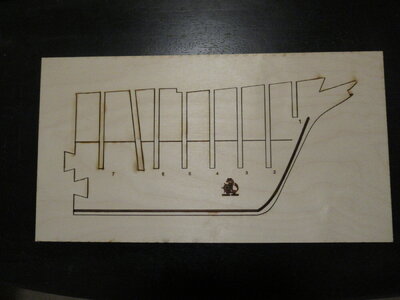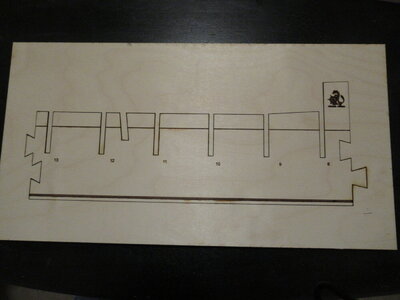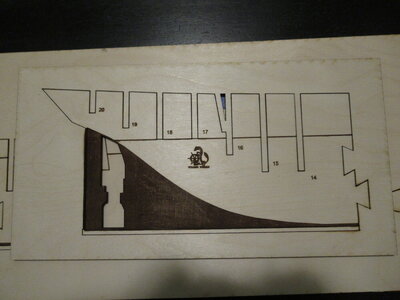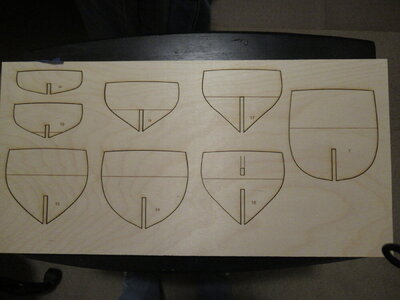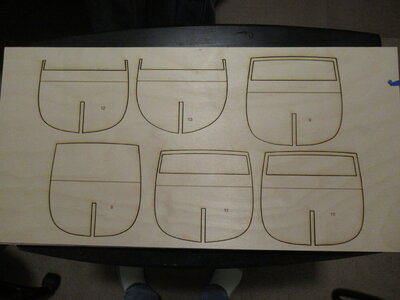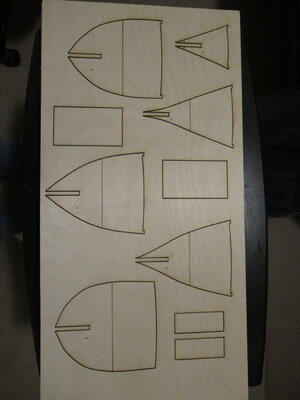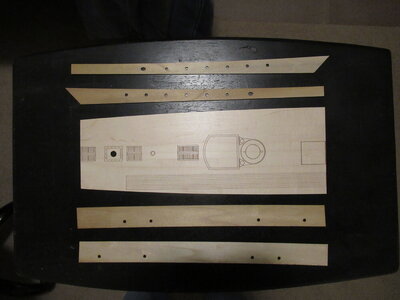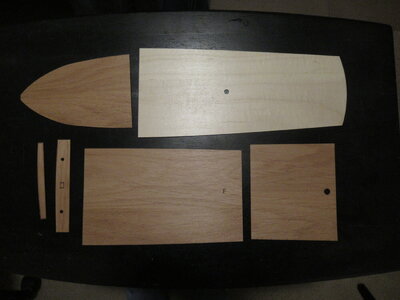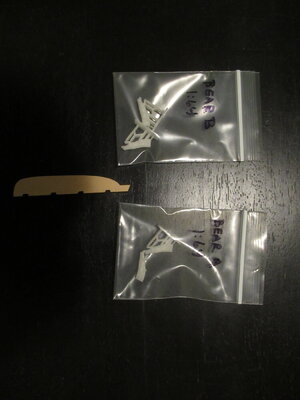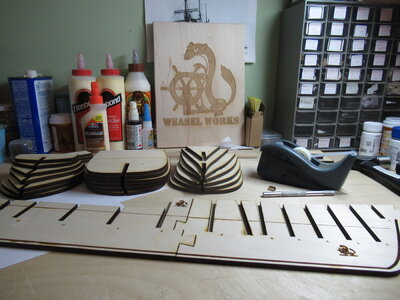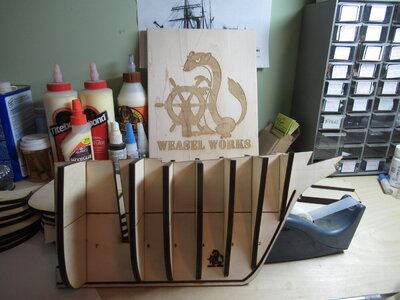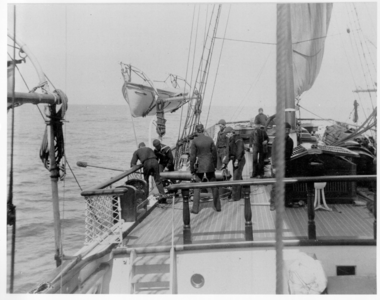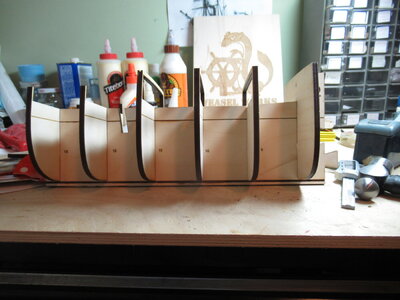I haven't really been posting much here lately. The reason is that for the past several months my good friend Mike Shanks and I have been working on creating a model of one of the most famous ships in the history of the Coast Guard as well as exploration. For those of you who are not familiar with this fine old ship let me introduce you to her with a brief history.
REVENUE CUTTER BEAR

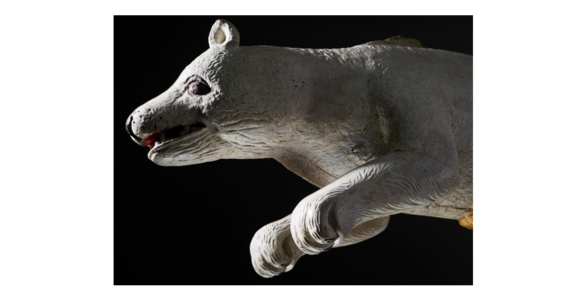
I purchased the plans from the Smithsonian back in 1985 and have been sitting on them ever since. The reason I bought the plans in the first place is the “Admiral”, being a semi-professional genealogist, had an ancestor who served aboard this fine ship, at one point in his sailing career. 
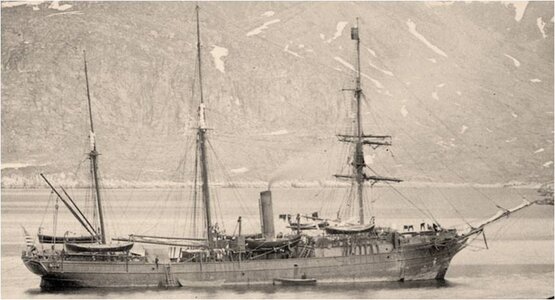
This ship is one of the most famous ships in the history of exploration, as well as the “pride” of the early Coast Guard. She is the USCG Revenue Cutter Bear! Built and launched in 1874, in Dundee, Scotland, by Alexander Stephens and Sons, Ltd. Of Greenock, Scotland. Her original owner of record was W. Grieve and Sons. She was purpose built for the sealing trade. She was 198.5 feet in length with a 30 foot beam and a draft of 18.8 feet. Her displacement was 703 tons. Rigged as a barkentine, the ship was also equipped with a 300 ihp compound steam engine. Her hull was planked with 6” thick oak, covered with 4” thick Australian ironwood, and the bow was strengthened with steel plate to help her cut through the ice found in the seal hunting grounds. After a brief career hunting seals, she was purchased by the U.S. Govt. in 1884. The original name of the ship was simply the “Bear”, but upon her acquisition by the govt. she was given the title of USRC Bear. Shortly after the purchase of the Bear, she was sent on a relief expedition to the Arctic to relieve the Greely Expedition who had been trapped there for almost 4 years without any re-supply. The whole story of the ill-fated expedition is too long to go into here, suffice it to say that it was a disaster, resulting in insanity, threats of mutiny, and cannibalism. Only 6 men survived the ordeal.
The Bear served as a revenue cutter in the U.S. Revenue Marine from 1885 to 1894, and the U.S. Revenue Cutter Service from 1894 to 1915. She also served in the U.S. Coast Guard from 1915 to 1926. Throughout the years she made the seasonal trek each May from her port in Oakland, California, to sail north to the waters of the Territory of Alaska for the 5 month season, cruising 10,000 nautical miles (12,000 mi.) on the Bering Sea Patrol, where she looked out for seal poachers, shipwrecked whalers, and illicit trade with the Alaskan natives, among other duties.
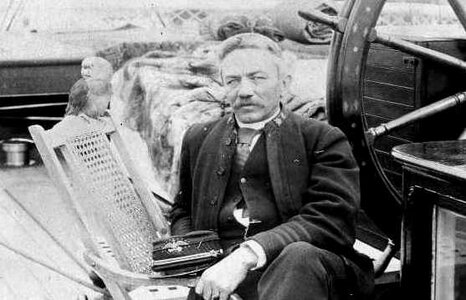
One captain of the Bear, Michael “Hell Roaring Mike” Healy, was the first African-American commissioned officer in U.S. history, and during Healy’s and the Bear’s 1891 Bering Sea Patrol, the following was accomplished:
* Secured witnesses for a murder trial
* Ferried reindeer
* transported a USGS survey team
* carried lumber and supplies for school construction in
remote areas
* delivered teachers to their remote assignments
* delivered mail for the USPS
* enforced federal laws
* provided medical support to the native populations
* conducted search and rescue operations.
In 1896 Healy was relieved of command after 10 grueling years on the sea patrol. He would later be re-instated, and served on other cutters before retiring in 1903.
In 1897, eight whaling ships became trapped in the ice near Point Barrow, Alaska, and for the second time in her career, the Bear would support an heroic rescue operation. The Bear took on supplies and sailed north from Port Townsend, Washington. This would be the largest of several rescues of American whalers undertaken by the Bear during the heyday of Arctic whaling.
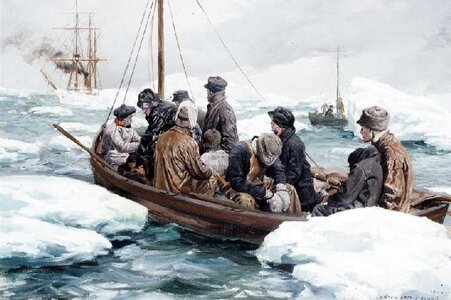
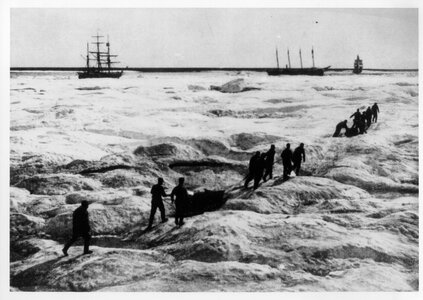
To lead the so-called Overland Relief Expedition, the Bears captain, Francis Tuttle tasked a team of 6 men, with driving a herd of reindeer to the whaling ships. In late March of 1898, after over 3 months and 1500 miles, the rescue party arrived at Point Barrow, delivering the much needed supplies to the starving whalers with no loss of human life.
Gold had been discovered in Canada’s Klondike in 1896 bringing with it thousands of prospectors, miners and their followers to Alaska’s coastal towns. This rapid in-flux of people brought with it the need for law enforcement, medical services and humanitarian relief. The Bear, and other cutters, provided these services.
The Bear also provided relief in San Francisco after the earthquake of 1906 devastated the area. During this time the officers and crew of the Bear worked with the U.S. Army units stationed there under the command of General Adolphus Greely, the same man rescued by the Bear years earlier.
By the mid 1920’s the Bear had served Alaska for over 40 years and over 30 Bearing Sea patrols. In 1927, President Calvin Cooledge signed the Bear over to the City of Oakland to become a historic museum ship. But that’s not the end of her story.
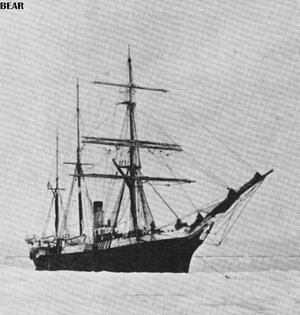
After her retirement from the Coast Guard and a brief career as a museum ship the Bear was acquired by Admiral Richard Byrd to be used as one of his two ships for his first Antarctic expedition. He acquired the ship for a grand total of $1050.00. During the first expedition Byrd founded the well-known research base at Little America. He returned home in 1930 and used the Bear on his second expedition in 1933. Describing his trusted ice-ship, Byrd claimed: “There was a joy and spirit to the Bear’s attack… She was built for the ice… She could lower her head and bore in. Therein lay the merit of the honorable and ancient Bear.”
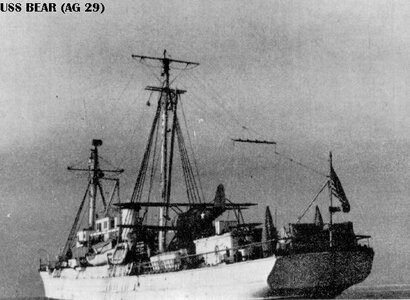
In the late 1930’s Byrd was placed in charge of the United Stated Antarctic Service and in 1939 once again used the Bear to reach his base in Little America. Prior to the trip the Bear was refitted. Her barkentine rig was changed in order to place an airplane on her deck and her new diesel engine no longer required the tall stack of the old coal-
burning power plant. By 1941, with war looming on the horizon, the Bear returned to the US bringing the personnel from the Arctic bases home with her.
Upon her return the Navy cut down the masts to support radio gear, added modern armament and equipped the ship to carry an amphibious aircraft. As a part of the Greenland Patrol, the Bear cruised Greenland’s waters and, in October 1941, brought home the German Trawler "Buskoe", the first enemy vessel captured by the US in WWII.
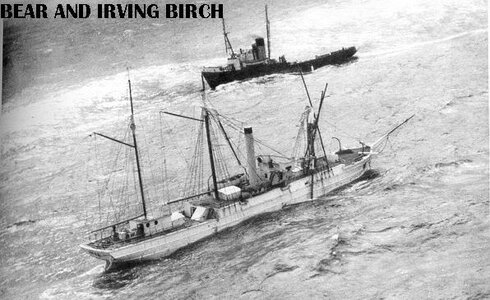
In May 1944, the Navy decommissioned the Bear for the last time. Bear remained in surplus until 1948 even though its timbers were still sound. Buyers from Halifax, NS purchased the Bear hoping to use the cutter in the sealing trade once again, but that trade was on its way out and as a result the Bear remained in Halifax for years before her owners finally sold her to a Philadelphia restaurant developer for use as a floating eatery. In March 1963 a seagoing tug started taking the old cutter to her new home. During the trip, heavy seas developed and at a point about 200 miles off the Massachusetts coast the Bear parted the tug’s cable. The snapping of the cable caused her fore-mast to shear off, which punctured her hull and she sank beneath the waves at 9:10 am on March 19, 1963 at the venerable old age of 89 years.
Citations: Wikipedia, US Coast Guard “Compass”, and Haze Grey. Org.
REVENUE CUTTER BEAR


I purchased the plans from the Smithsonian back in 1985 and have been sitting on them ever since. The reason I bought the plans in the first place is the “Admiral”, being a semi-professional genealogist, had an ancestor who served aboard this fine ship, at one point in his sailing career. 

This ship is one of the most famous ships in the history of exploration, as well as the “pride” of the early Coast Guard. She is the USCG Revenue Cutter Bear! Built and launched in 1874, in Dundee, Scotland, by Alexander Stephens and Sons, Ltd. Of Greenock, Scotland. Her original owner of record was W. Grieve and Sons. She was purpose built for the sealing trade. She was 198.5 feet in length with a 30 foot beam and a draft of 18.8 feet. Her displacement was 703 tons. Rigged as a barkentine, the ship was also equipped with a 300 ihp compound steam engine. Her hull was planked with 6” thick oak, covered with 4” thick Australian ironwood, and the bow was strengthened with steel plate to help her cut through the ice found in the seal hunting grounds. After a brief career hunting seals, she was purchased by the U.S. Govt. in 1884. The original name of the ship was simply the “Bear”, but upon her acquisition by the govt. she was given the title of USRC Bear. Shortly after the purchase of the Bear, she was sent on a relief expedition to the Arctic to relieve the Greely Expedition who had been trapped there for almost 4 years without any re-supply. The whole story of the ill-fated expedition is too long to go into here, suffice it to say that it was a disaster, resulting in insanity, threats of mutiny, and cannibalism. Only 6 men survived the ordeal.
The Bear served as a revenue cutter in the U.S. Revenue Marine from 1885 to 1894, and the U.S. Revenue Cutter Service from 1894 to 1915. She also served in the U.S. Coast Guard from 1915 to 1926. Throughout the years she made the seasonal trek each May from her port in Oakland, California, to sail north to the waters of the Territory of Alaska for the 5 month season, cruising 10,000 nautical miles (12,000 mi.) on the Bering Sea Patrol, where she looked out for seal poachers, shipwrecked whalers, and illicit trade with the Alaskan natives, among other duties.


One captain of the Bear, Michael “Hell Roaring Mike” Healy, was the first African-American commissioned officer in U.S. history, and during Healy’s and the Bear’s 1891 Bering Sea Patrol, the following was accomplished:
* Secured witnesses for a murder trial
* Ferried reindeer
* transported a USGS survey team
* carried lumber and supplies for school construction in
remote areas
* delivered teachers to their remote assignments
* delivered mail for the USPS
* enforced federal laws
* provided medical support to the native populations
* conducted search and rescue operations.
In 1896 Healy was relieved of command after 10 grueling years on the sea patrol. He would later be re-instated, and served on other cutters before retiring in 1903.
In 1897, eight whaling ships became trapped in the ice near Point Barrow, Alaska, and for the second time in her career, the Bear would support an heroic rescue operation. The Bear took on supplies and sailed north from Port Townsend, Washington. This would be the largest of several rescues of American whalers undertaken by the Bear during the heyday of Arctic whaling.




To lead the so-called Overland Relief Expedition, the Bears captain, Francis Tuttle tasked a team of 6 men, with driving a herd of reindeer to the whaling ships. In late March of 1898, after over 3 months and 1500 miles, the rescue party arrived at Point Barrow, delivering the much needed supplies to the starving whalers with no loss of human life.
Gold had been discovered in Canada’s Klondike in 1896 bringing with it thousands of prospectors, miners and their followers to Alaska’s coastal towns. This rapid in-flux of people brought with it the need for law enforcement, medical services and humanitarian relief. The Bear, and other cutters, provided these services.
The Bear also provided relief in San Francisco after the earthquake of 1906 devastated the area. During this time the officers and crew of the Bear worked with the U.S. Army units stationed there under the command of General Adolphus Greely, the same man rescued by the Bear years earlier.
By the mid 1920’s the Bear had served Alaska for over 40 years and over 30 Bearing Sea patrols. In 1927, President Calvin Cooledge signed the Bear over to the City of Oakland to become a historic museum ship. But that’s not the end of her story.


After her retirement from the Coast Guard and a brief career as a museum ship the Bear was acquired by Admiral Richard Byrd to be used as one of his two ships for his first Antarctic expedition. He acquired the ship for a grand total of $1050.00. During the first expedition Byrd founded the well-known research base at Little America. He returned home in 1930 and used the Bear on his second expedition in 1933. Describing his trusted ice-ship, Byrd claimed: “There was a joy and spirit to the Bear’s attack… She was built for the ice… She could lower her head and bore in. Therein lay the merit of the honorable and ancient Bear.”


In the late 1930’s Byrd was placed in charge of the United Stated Antarctic Service and in 1939 once again used the Bear to reach his base in Little America. Prior to the trip the Bear was refitted. Her barkentine rig was changed in order to place an airplane on her deck and her new diesel engine no longer required the tall stack of the old coal-
burning power plant. By 1941, with war looming on the horizon, the Bear returned to the US bringing the personnel from the Arctic bases home with her.
Upon her return the Navy cut down the masts to support radio gear, added modern armament and equipped the ship to carry an amphibious aircraft. As a part of the Greenland Patrol, the Bear cruised Greenland’s waters and, in October 1941, brought home the German Trawler "Buskoe", the first enemy vessel captured by the US in WWII.


In May 1944, the Navy decommissioned the Bear for the last time. Bear remained in surplus until 1948 even though its timbers were still sound. Buyers from Halifax, NS purchased the Bear hoping to use the cutter in the sealing trade once again, but that trade was on its way out and as a result the Bear remained in Halifax for years before her owners finally sold her to a Philadelphia restaurant developer for use as a floating eatery. In March 1963 a seagoing tug started taking the old cutter to her new home. During the trip, heavy seas developed and at a point about 200 miles off the Massachusetts coast the Bear parted the tug’s cable. The snapping of the cable caused her fore-mast to shear off, which punctured her hull and she sank beneath the waves at 9:10 am on March 19, 1963 at the venerable old age of 89 years.
Citations: Wikipedia, US Coast Guard “Compass”, and Haze Grey. Org.



